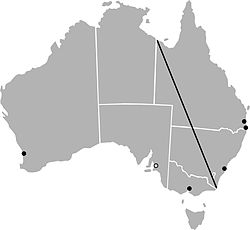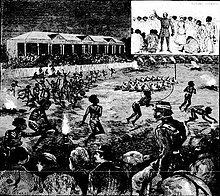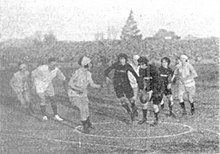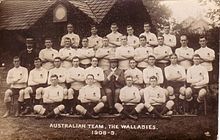Football in Australia
Rugby League is the most watched sport in Australia based on television viewership, however, Australian football attracts larger live attendences.Australian sport fans have historically attended events in large numbers, dating back to the country's early history.[49] Australian sport fans have behaved unruly at times, with police being required at football games dating back to the 1860s.[52] The 1914 Great Britain Lions tour of Australia and New Zealand included a match in Melbourne, the first rugby league game to be played in Victoria.The Matildas vs England semi-final in the 2023 FIFA Women's World Cup set the record television audience for a sports program in Australia, 11.15 million.This also includes the earliest dates for areas where a code was dormant for long periods of time (such as Australian rules in New South Wales and Queensland and rugby in Tasmania).Participation in soccer follows most closely Australia's demographic distribution being strongest in the major cities (6%) with more than 3 in 4 of its players found in Sydney, Melbourne or Brisbane.Rugby league has grown its hold in New South Wales and strengthened its position in the Australian Capital Territory as well as its participation across the Barassi Line in Victoria and Western Australia.[153] Indigenous pioneers include Harry Hewitt, Jimmy Melbourne, Joe Johnson, Douglas Nicholls and Graham Farmer.All-indigenous sides have been documented as early the turn of the 19th Century[155] and the first representative teams began playing matches after World War II.Other notable indigenous soccer players included Charlie Perkins who played and coached Pan-Hellenic and Harry Williams who was a member of the Australian team at the 1974 FIFA World Cup.Rugby Union too has a rich history of Aboriginal participation with notable indigenous athletes such as the Ella brothers, Mark, Gary and Glen as well as Kurtley Beale all past members of the Wallabies.In 2017, a record number of 463,364 females were playing Australian Football across the nation, making up 30% of all participants and overtaking women's soccer for the first time in history.[182] The use of Cambridge and Harrow rules meant that the forms of football being played in Victoria, South Australia and to a lesser extent Tasmania would have appeared relatively familiar in comparison to rugby.[188] Between 1865 and 1866, fledgling Sydney clubs began to adop Australian rules however quickly turned its back on the Victorian code mainly due to the strong intercolonial rivalry and pushed for the adoption of rugby.[190] As part of its charter, the newly formed New South Wales Rugby Union in 1874 banned its clubs from playing matches under Victorian rules.[148]: 175 After news that Sydney had chosen rugby, Brisbane clubs soon began to follow, though the code continued to co-exist with Victorian rules for some time.[205] During the 1980s and 1990s both Australian Football and Rugby league's major peak governing bodies changed their names to reflect a more nation-wide approach and added expansion teams outside their traditional areas.While the VFL attempted to expand into Sydney, Australian Football lost its dominance in the ACT in 1982 to rugby league, and became a minor sport in both places.During the 1990s, soccer faced a challenge in attracting youth players because of the ethnic nature of the sport at the highest levels of national competition.At the same time, rival football codes were intentionally trying to bring in ethnic participants in order to expand their youth playing base.[206] 73,811 people attended a gridiron National Football League game between the Denver Broncos and San Diego Chargers at ANZ Stadium in Sydney in 1999.[207] In March 1999, 104,000 fans attended a double header match in the National Rugby League at Stadium Australia four days after the venue formally opened.The COVID-19 pandemic had an immense effect on both Australian Football and Rugby league, causing the two code's flagship events to leave their traditional host cities for the first time.[214] Unlike in Europe and the United States, professional clubs tend to be member run organisations instead of single owner, for profit businesses.[215] The major football codes and professional leagues in the country all watch what their competition does in order to improve their own strategic picture in the Australian sporting landscape.At the same time, the AFL had highest level of corporate support with major national and international sponsors such as Air Emirates, Vodafone and Toyota.[222] Rugby league, which includes NRL, State of Origin and national team matches, had the highest aggregate television ratings of any sport in 2009[223] and 2010.[224] Also, in a world first, the Nine Network broadcast free-to-air the first match of the 2010 State of Origin series live in 3D in New South Wales, Queensland and Victoria.[228] The film was written by David Williamson, directed by Bruce Beresford and starring John Howard, Jack Thompson, Graham Kennedy and Frank Wilson.







Australian rules footballFootball AustraliaSoccer in AustraliaAustralian footballAdelaide OvalSouth AustraliaRugby leagueSuncorp StadiumQueenslandRugby unionSuper RugbyANZ StadiumNew South WalesSoccerA-leagueAAMI ParkVictoriaPaul SheehanAustraliaAustralian Football LeagueNational Rugby Leaguerugby footballRugby League State of Originperformance at the FIFA World CupFIFA Women's World CupImmigration to Australiainternal migrationFederation of AustraliaWomen's soccerWomen's Australian footballAustralian regional rivalriesBarassi LineMatildasSocceroosWallabiesKangaroosassociation footballUnited StatesCanadaVictorian Football AssociationAustralian rules football in AustraliaAFL CommissionAFL Women'sAFL Under 19 ChampionshipsAFL Women's Under 18 ChampionshipsVictorian Football LeagueRugby League in AustraliaAustralian Rugby League CommissionAffiliated States ChampionshipA-League MenA-League WomenAustralia CupRugby union in AustraliaRugby AustraliaSuper Rugby AUSuper WGridironGridiron in AustraliaGridiron AustraliaAustralian Gridiron LeagueGaelic footballGaelic football in AustraliaAustralasia GAATasmanian AFL bidTasmanian A-League bidCanberra A-League BidNew South Wales WaratahsNRC Division 2Queensland RedsACT BrumbiesAFL State of Origin SeriesWestern AustraliaTasmaniaAustralian Capital TerritoryNorthern Territory1914 Great Britain Lions tour of Australia and New ZealandMelbourneEnglandAustralian Bureau of StatisticsGrand Final2023 FIFA Women's World CupW-League2023–24 A-League WomenAmerican FootballcorroboreeMarngrookHarry HewittJimmy MelbourneJoe JohnsonDouglas NichollsGraham FarmerBrownlow MedalGavin WanganeenAdam GoodesMadison PrespakisAlly AndersonAFL Women's best and fairestIndigenous All-StarsPapua New GuineaFlying BoomerangsJohn Kundereri MoriartyCharlie PerkinsPan-HellenicHarry Williams1974 FIFA World CupRedfern, New South WalesRedfern All BlacksArthur BeetsonKurtley Bealewomen's and girlsWomen's Australian rules footballWomen's soccer in AustraliaWomen's rugby league in AustraliaMarn GrookWurundjeriAustralia's convict colonial periodColony of New South WalesVan Diemen's LandPort Phillip DistrictColony of South AustraliaColony of Queenslandhacking shinsmob footballEton footballHarrow footballCambridge rules